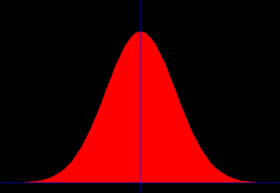Errors
In astronomy almost every quantity we observe has an associated error often
expressed as a ![]() quantity after the value, ie:
quantity after the value, ie:
![]()
suggests that our best estimate of the mass ![]() is 4.1 M
is 4.1 M![]() but that
but that
it could easily be 1.0 M![]() more or less than that.
more or less than that.
Sometimes astronomers choose to drop the ![]() and just put the error in the last digit in parentheses (brackets). So in the example above this would be somewhat confusingly written as:
and just put the error in the last digit in parentheses (brackets). So in the example above this would be somewhat confusingly written as:
![]()
Novices sometimes think this means ![]() – it does not!
– it does not!
More awkwardly, if the best estimate was ![]() then we could have written:
then we could have written:
![]()
which is equivalent to
![]() !
!
Normal or Gaussian Distributions

In nature when we make a series of measurements they
often follow a Gaussian or Normal distribution like that shown above.
often follow a Gaussian or Normal distribution like that shown above.
What does this really mean? Well, astronomers usually set the error to mean there is a 67% chance that the true value falls within one listed error of the value. If the measurements are distributed “normally”, ie in a Gaussian fashion, then there is about a 96% chance the value is within twice the listed error and a >99% chance it is within three times the error. The error is often referred to as “sigma”. So a 1-sigma result is quite poor, whereas a 3-sigma result reasonably secure. The sigma comes from the standard deviation of a Gaussian distribution.
Study Astronomy Online at Swinburne University
All material is © Swinburne University of Technology except where indicated.

